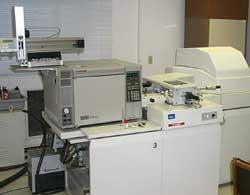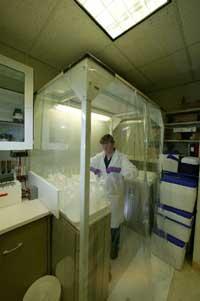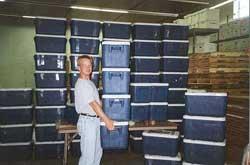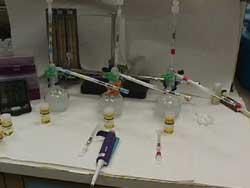National Study of Chemical Residues in Lake Fish Tissue - Fish Tissue Sample Preparation and Analysis
Sample Preparation

EPA and participating agencies collected fish composite samples from 500 lakes and reservoirs during the four sampling years of the National Lake Fish Tissue Study (2000-2003). EPA controlled variability in the sample preparation by utilizing a single laboratory to prepare, composite, homogenize, and aliquot samples in a strictly controlled, contaminant-free environment prior to sample analysis. For sample analysis, the Agency used the same laboratory for each type of analysis, and laboratories applied the same analytical method for each chemical for the duration of the study.
Laboratory staff performed all sample preparation, filleting, and homogenization activities in accordance with EPA's Guidance for Assessing Chemical Contaminant Data for Use in Fish Advisories, Volume 1: Fish Sampling and Analysis (Third Edition, November 2000) (PDF) (485 pp, 4 MB, About PDF). Bottom-dwelling species were composited as whole fish (i.e., the entire specimen, including the head, skin, internal organs, muscle, and bones were thoroughly homogenized). Predators or gamefish were composited as skin-on (scales removed, with belly flap attached) fillets. Once the tissue was homogenized and composited, sample aliquots were prepared for distribution to each of the analytical laboratories. Extra volume aliquots were shipped to a sample repository for archiving.
Target Chemicals

The laboratories under contract to EPA analyzed the fish tissue samples for the following target chemicals:
- 2 metals (mercury and 5 forms of arsenic)
- 17 dioxins and furans
- 159 PCB congener measurements (representing results for 209 congeners)
- 46 pesticides
- 40 other semi-volatile organics (e.g., phenols)
For a complete list of all target chemicals, refer to the National Lake Fish Tissue Study Target Analyte (Chemical) List.
Analytical Methods

Laboratories employed the following analytical methods for analysis of the fish tissue samples:
EPA Method 1631, Revision B (Mercury in Water by Oxidation, Purge and Trap, and Cold Vapor Atomic Fluorescence Spectrometry) and its Appendix (Digestion Procedures for the Determination of Total Mercury in Tissue, Sludge, Sediment, and Soil) to measure total mercury (Hg) concentrations.
EPA Method 1632, Revision A (Chemical Speciation of Arsenic in Water and Tissue using Hydride Generation Quartz Furnace Atomic Absorption Spectrometry) to directly determine total inorganic arsenic, arsenic (III), monomethylarsonic acid (MMA), and dimethylarsinic acid (DMA) concentrations. Arsenic (V) concentrations were derived by mathematically subtracting the measured concentration of arsenic (III) from the measured concentration of total inorganic arsenic for each composite sample.
EPA Method 1613, Revision B (Tetra- through Octa- Chlorinated Dioxins and Furans by Isotope Dilution HRGC/HRMS, EPA 821-B-94-005) to determine the concentrations of seventeen 2,3,7,8-substituted chlorinated dibenzo-p-dioxins and dibenzofurans (CDDs and CDFs) using a slightly modified version of this method.
EPA Method 1668, Revision A (Chlorinated Biphenyls Congeners in Water, Soil, Sediment, and Tissue by HRGC/HRMS, EPA 821-R-00-002) to measure PCB congener concentrations.
EPA Method 1656, Revision A (Organo-Halide Pesticides in Wastewater, Soil, Sludge, Sediment, and Tissue by GC/HSD) to measure concentrations of organochlorine pesticides and total Aroclors. Sample extracts were concentrated by a factor of five beyond method-specified levels (before instrumental analysis) in order to ensure that all target pesticides could be quantified at levels equal to or lower than the screening values published in EPA's Guidance for Assessing Chemical Contaminant Data for Use in Fish Advisories, Volume 2: Risk Assessment and Fish Consumption Limits (Third Edition, November 2000) (PDF) (383 pp, 1 MB, About PDF).
EPA Method 1657, Revision A (Organophosphorus Pesticides in Water, Soil, and Tissue by GC/FPD ) to determine the presence and concentrations of organophosphorus pesticides.
EPA Method 1625, Revision C (Semivolatile Organic Compounds by Isotope Dilution GC/MS) to analyze the remainder of the target organic chemicals.
The Analytical Methods Summary under Documents provides a description of each of the methods used for fish tissue analysis during the study.
Quality Assurance (QA) Program
In addition to the Quality Assurance Project Plan (QAPP) for sample collection activities, EPA developed a separate QAPP for analytical control and assessment activities. The Quality Assurance Project Plan for Analytical Control and Assessment Activities in the National Study of Chemical Residues in Lake Fish Tissue (September 2000) identifies method quality objectives (MQOs) for laboratory data generated during the study and describes QA/QC techniques employed by laboratory and Sample Control Center staff to ensure that these goals were met.

The Sample Control Center subjects all analytical data to three levels of review:
- A pre-qualification review was performed on data submitted by each laboratory to demonstrate that the labs were qualified to prepare and/or analyze tissue samples collected during the study.
- Each submission of sample results was carefully scrutinized to verify that the samples were analyzed as directed and that supporting QC results demonstrate the quality of results. In evaluating these submissions, data reviewers employed a suite of standardized data qualifiers to consistently and accurately document the quality of all data so that both the primary data users (e.g., EPA statisticians) and secondary data users within states, tribes, and other organizations can make informed decisions regarding their use.
- A third level of data review was performed annually at the conclusion of the data review processes to determine if overall data quality supported study objectives. These end-of-year evaluations indicated that all MQOs were met.
Documents

- National Lake Fish Tissue Study Target Analyte (Chemical) List
This list contains the chemicals included in the analysis of fish tissue samples collected during the four years of the study and the reporting limits for each chemical (including the method detection limit and the minimum level or quantitation limit). The chemicals are arranged by analytical method and listed alphabetically under each method. - Analytical Methods Summary
This summary describes each of the analytical methods used for chemical analysis of fish tissue samples for the National Lake Fish Tissue Study. - Quality Assurance Report for the National Study of Chemical Residues in Lake Fish Tissue: Analytical Data for Years 1 through 4 (EPA 823-R-05-005)
The Quality Assurance Report documents the quality of fish tissue data for samples collected during the four sampling years of the National Lake Fish Tissue Study (2000-2003). It provides a brief overview of the study, a description of the QA program for the study, a summary of analytical methods used in the study, and an assessment of the fish tissue data quality. - Quality Assurance Project Plan for Analytical Control and Assessment Activities in the National Study of Chemical Residues in Lake Fish Tissue (EPA 823-R-02-006)
The Quality Assurance Project Plan (QAPP) describes the quality assurance/quality control (QA/QC) requirements for analytical activities being conducted for the National Lake Fish Tissue Study. It was approved by the Office of Science and Technology's (OST) Quality Assurance Officer in September 2000.
